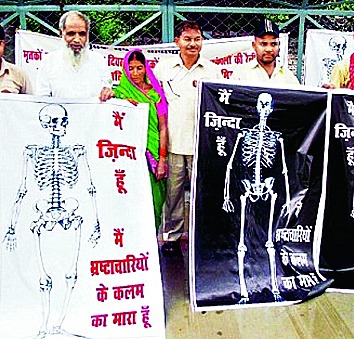
In 1968, George A. Romero, an independent film-maker, directed Night of the Living Dead. The film was about a burgeoning population of 'living-dead monsters' terrorizing a group of people in rural Pennsylvania. It featured Duane Jones and Judith O'Dea in leading roles. Surprisingly, Romero had not cast Lal Bihari Tiwari in his flick. Tiwari - he had been declared dead in official records from 1976 to 1994 - holds the distinction of being India's most renowned zombie, a person who, for no fault of his, was made a resident of the twilight zone between life and death for 18 long years.
Tiwari's tribulations began when, while applying for a loan, he discovered that a family member had connived with corrupt government officials to produce a false death certificate to declare him deceased in order to take over his land. He got his 'life' and land back only in 1994 after a protracted battle against an insensitive bureaucracy. It had been a scarring conflict. Tiwari was forced to undertake innovative measures to prove that he was alive. Among other things, he contested elections against two former prime ministers - Rajiv Gandhi and V.P. Singh - and also kidnapped his nephew in the hope that an arrest warrant, would, ironically, confirm that he was alive in the eyes of law-keepers.
But Tiwari is, by no means, India's only living dead. In late October, The Telegraph reported that 35 elderly residents of Pipariya village in Uttar Pradesh - 20 of them women and the majority Dalits - had been denied subsidized food grains and old-age pensions for over one and a half years. On enquiring what the matter was, they were told by the social welfare department that they no longer existed as living beings on the rolls. It turned out that the panchayat chief and secretary had, figuratively speaking, got their last rites performed after the victims refused to pay bribes to get their ration cards renewed.
The State may have forsaken those who are dead, but only on paper. Their exact number eludes the register. But they have found refuge in the Mritak Sangh - the Association of the Dead - an organization founded by Tiwari, which seeks to address the grievances of Indians who are alive yet dead. The Sangh, whose membership has risen to around 20,000, has helped annul over 30 forged death certificates and restored some land titles.
Tiwari and his Mritak Sangh attract periodic attention, more for their bizarre means of protest than for the serious lapses in India's welfare mechanism. Corruption, as is evident from the case in Pipariya, remains endemic , denying vulnerable citizens mandatory entitlements assured by legislation. Much has been made about technology being an effective tool to bridge leakages. Direct cash transfers and the Aadhaar scheme have been held out as possible remedies. But the recent claims of hunger deaths in Jharkhand, where families were allegedly denied rations because their Aadhaar cards had not been linked to the public distribution system, show, worryingly, that technological interventions remain vulnerable to human agency that is unscrupulous.
The undead speak of a moral crisis that is layered. The issue is not just about corruption eroding the edifice of welfare. The discourse on the life and 'death' of Tiwari and other sufferers - the media influence this - is usually contemptuous of their exclusion. The Indian State, evidently, is not respectful of all its dead. Is it because some among the dead tell tales?










